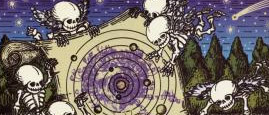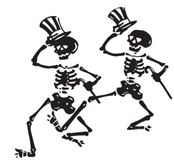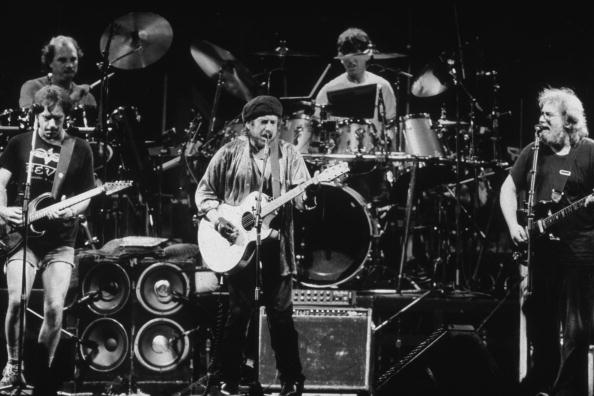By David Dodd
Here’s the plan—each week, I will blog about a different song, focusing, usually, on the lyrics, but also on some other aspects of the song, including its overall impact—a truly subjective thing. Therefore, the best part, I would hope, would not be anything in particular that I might have to say, but rather, the conversation that may happen via the comments over the course of time—and since all the posts will stay up, you can feel free to weigh in any time on any of the songs! With Grateful Dead lyrics, there’s always a new and different take on what they bring up for each listener, it seems. (I’ll consider requests for particular songs—just private message me!)
A new book is coming out very soon from Simon & Schuster, who are also my publishers. It’s a collection of the lyrics of Bob Dylan, in a definitive edition complete with variant versions of the words, scholarly essays, and, possibly, some degree of annotation—the working title for several months had been The Complete Annotated Bob Dylan Lyrics. The actual title is now The Lyrics: Since 1962, and the publication date is October 28. I plan to buy a copy—although not the autographed version, which goes for $5,000. It checks in at a shipping weight of over 15 pounds, 916 pages, and is roughly the size of an LP. Comes in a grey slipcase.
Partly in honor of this publishing event, my first thought was to feature a post on the Bob Dylan covers the Dead slipped into their repertoire over the years. Clearly, calling Dylan an influence on the Dead is an understatement.
The Grateful Dead Lyric and Song Finder lists 39 songs by Dylan played by the Dead. Of those, a large number are performances of the Dead backing Dylan on their joint tour. But there are 11 or 12 songs that were staples of the Dead’s own repertoire. And of those, there are a number that were played often enough to be considered favorites of the band. “It’s All Over Now, Baby Blue,” was played 145 times. “Queen Jane, Approximately”: 129. “All Along the Watchtower”: 123. “Knockin’ On Heaven’s Door”: 76. But for me, the quintessential Dylan song performed by the Dead was always “Desolation Row,” which was performed only 58 times.
There’s so much in the song—such a torrent of words, and it seemed to go on so long at time that it was almost humorous. I remember hearing an anecdote about the Dead/Dylan tour, during which Dylan called for “Desolation Row,” and Weir asked him if he remembered all the words. “I’ll remember the ones that matter,” was Dylan’s reply.
I did submit a book proposal for a Complete Annotated Bob Dylan Lyrics, and the sample song I annotated was “Desolation Row.” So I have spent some time with the song, although I could not stand up in front of a crowd and sing it beginning to end without forgetting any words, I’m certain of that. The word count comes in at 665. To compare, “China Cat Sunflower” has less than 100 words. Of course, that’s a simplistic point in many ways—a seventeen syllable haiku can contain worlds of meaning, after all.
But I think that it was something about the sheer volume of words, of references, of visuals and unseen plots and relationships contained within those words that lent the song a part of its meaning. As if Dylan was saying—look, everyone: the world, our country with its unsavory history, and our place in it and everyone’s place in it, is not something that you can just summarize in a neat sentence. It’s extremely complicated, and deserves your consideration on as deep a level as you might care to take it to.
So, just for fun, I’m going to post my annotated version of the lyrics to “Desolation Row,” as this week’s “Greatest Stories Ever Told” entry. I’ll enjoy hearing your reactions, additions, and most importantly, corrections!
Desolation Row [1]
They're selling postcards of the hanging[2]
They're painting the passports brown[3]
The beauty parlor is filled with sailors
The circus is in town
Here comes the blind commissioner
They've got him in a trance
One hand is tied to the tight-rope walker
The other is in his pants
And the riot squad they're restless
They need somewhere to go
As Lady [4] and I look out tonight
From Desolation Row
-------------------------------------------------------
[1] Desolation Row
Final track of Highway 61 Revisited. Recorded August 4, 1965.
Desolation Row was listed as song number 185 in Rolling Stone’s top 500 songs of all time list.
In 1969, Dylan told Rolling Stone he wrote this song in the back of a New York cab. … It was spliced together from two consecutive takes during the last sessions for Highway 61. (RS Dec. 2004)
First performed at the Forest Hills Music Festival in Queens, New York on August 28, 1965.
Dylan spoke to USA Today's Edna Gundersen about the song on September 10th, 2001: “And Desolation Row? That's a minstrel song through and through. I saw some ragtag minstrel show in blackface at the carnivals when I was growing up, and it had an effect on me, just as much as seeing the lady with four legs."
The Grateful Dead covered the song for a number of years in live performances, and when they teamed up with Dylan for the Summer 1987 Dylan and the Dead tour, Weir asked Dylan if he thought he could remember all the words to “Desolation Row,” before they launched into it. Dylan replied, “I’ll remember the ones that matter.” (For the record, Weir sometimes left out a verse here and there when they sang it.)
The song’s title contains at least two, and possibly a third, references. First to be called to mind is the Jack Kerouac novel, Desolation Angels, published in 1965. The novel had its origins much earlier, written around the same time as the publication of On the Road. The largely autobiographical work, in turn, takes its title from Desolation Peak, in Washinton State’s Cascade Mountains, where Kerouac was stationed as a fire lookout, and his journal from that period provided the basis for the novel.
The second reference is to Nobel Prize winner John Steinbeck’s Cannery Row, published in 1945, which follows the misadventures of a down-and-out group of Great Depression era residents of the Monterey, California neighborhood.
Lastly, this song, with its myriad of literary, biblical, and popular culture references, has something in common with the T.S. Eliot (mentioned in the song) masterwork, “The Waste Land,” and the two titles evoke the same stark landscape. Eliot’s poem dates from 1922, and is 434 lines in length. So numerous and obscure were the reference’s in Eliot’s work, that he himself provided footnotes to the poem.
[2] postcards of the hanging
This entire verse points toward events in Duluth, Minnesota, Dylan’s hometown, which occurred on June 15, 1920. (Side note: Duluth, like the song itself, is at the end of Highway 61.) Three African-American circus workers were lynched by a mob of residents when they were accused, falsely, as it turned out, of raping a local girl. The incident made national headlines. The James Robinson circus arrived in town on the previous day. Following that evening’s performance, 19-year-old Irene Tusken and a companion, 18-year-old James Sullivan, accused six circus workers of threatening Sullivan at knife-point and raping Tusken. No physical signs of assault were found when Tusker was examined by her family physician the following morning; nevertheless, the six workers were arrested and jailed. A mob of 5,000 to 10,000 stormed the jail and took three of the accused men for a mock trial where they were found guilty. Elias Clayton, Elmer Jackson, and Isaac McGhie were taken to the corner of 1st Street and 2nd Avenue East, where they were lynched. Postcards were printed of the lynched bodies, and sold.
The making of postcards of lynchings was not unique to Duluth’s dark day, however. Dylan’s influence by Billie Holiday is documented in the film “No Direction Home,” and she made the song “Strange Fruit,” by the Jewish poet and songwriter Abel Meeropol, famous in 1939, singing it at the close of many of her concerts for the next 20 years, and recording it in 1939 and 1944. “Strange Fruit” became the anthem of the movement against lynchings.
“Postcards of the Hanging” is the title of a 2002 compilation CD of performances of Bob Dylan songs by the Grateful Dead.
[3] painting the passports brown
U.S. Government Agents’ passports are brown instead of blue.
Also the title of a recording by Bruce Russell, released in 2001.
[4] Lady and I
Possibly a reference to Billie Holiday, whose nickname was Lady Day. Hence, both Dylan and Holiday looked out at, and sang about, the hangings by mobs.
Cinderella[5], she seems so easy
"It takes one to know one,"[6] she smiles
And puts her hands in her back pockets
Bette Davis[7] style
And in comes Romeo[8], he's moaning
"You Belong to Me I Believe"[9]
And someone says," You're in the wrong place, my friend
You better leave"
And the only sound that's left
After the ambulances go
Is Cinderella sweeping up
On Desolation Row
Now the moon is almost hidden
The stars are beginning to hide
The fortunetelling lady
Has even taken all her things inside
All except for Cain and Abel[10]
-------------------------------------------------------
[5]Cinderella
An ancient, archetypal figure in folk literature, found throughout the world. The character embodies one who is wrongly discounted, whose true attributes are unknown or unappreciated, but who eventually proves everyone wrong by virtue of great success. Dylan’s son, Jakob, used the character in his Wallflowers song “One Headlight”: “But me & Cinderella / We put it all together / We can drive it home / With one headlight.”
[6]It takes one to know one
"Only a person with identical character traits would be able to recognize those traits in someone else. Often used as a curt rejoinder to deflect an accusation; you're only saying that about me because it's true of you. Originated in the late nineteenth or early twentieth century." From Random House Dictionary of Popular Proverbs and Sayings by Gregory Y. Titelman (Random House, New York, 1996)
[7]Bette Davis
April 5, 1908 – October 6, 1989. American actress. The “style” of putting her hands in her back pockets seems to derive from her habit of leaving her thumbs out.
[8]Romeo
Character from Shakespeare’s play “Romeo and Juliet,” whose ill-fated love for the daughter of a rival family, Juliet, led to a tragic end for both of them.
[9]You Belong to Me
Echoes of the 1965 Dylan song title “She Belongs to Me,” from “Bringing It All Back Home.”
[10]Cain and Abel
Biblical characters: the two sons of Adam and Eve. Cain murdered Abel, and when he was questioned about Abel’s whereabouts, asked if he was his brother’s keeper. The Biblical story of Cain and Abel is found in Genesis 4:8 ff.
And the hunchback of Notre Dame[11]
Everybody is making love
Or else expecting rain[12]
And the Good Samaritan,[13] he's dressing
He's getting ready for the show
He's going to the carnival tonight
On Desolation Row
Now Ophelia,[14]she's 'neath the window
For her I feel so afraid
-------------------------------------------------------
[11]The hunchback of Notre Dame
Character from the 1831 Victor Hugo novel, translated into English as The Hunchback of Notre Dame, whose name was Quasimodo. The novel’s original title in French was Notre Dame de Paris. He was born with “defomities”—a huge wart over one eye, and a hunchback, and was left as a foundling on the cathedral’s doorstep, on a Quasimodo Sunday, which is the first Sunday after Easter in the Catholic calendar. He is adopted and brought up as the cathedral bell-ringer, and loses his hearing as a result.
[12]Expecting rain
Used as the title of an early Bob Dylan fansite (www.expectingrain.com), created in 1995.
[13]Good Samaritan
The parable is found in the Gospel of Luke, chapter 10, verses 25–37.
“On one occasion an expert in the law stood up to test Jesus. "Teacher," he asked, "what must I do to inherit eternal life?". "What is written in the Law?" he replied. "How do you read it?" asked Jesus. The man answered: " 'Love the Lord your God with all your heart and with all your soul and with all your strength and with all your mind'; and, 'Love your neighbor as yourself.'" "You have answered correctly," Jesus replied. "Do this and you will live." But he wanted to justify himself, so he asked Jesus, "And who is my neighbor?" In reply Jesus said: (the parable starts here) "A man was going down from Jerusalem to Jericho, when he fell into the hands of robbers. They stripped him of his clothes, beat him and went away, leaving him half dead with no clothes. A priest happened to be going down the same road, and when he saw the man, he passed by on the other side. So too, a Levite, when he came to the place and saw him, passed by on the other side. But a Samaritan, as he traveled, came where the man was; and when he saw him, he took pity on him. He went to him and bandaged his wounds, pouring on oil and wine. Then he put the man on his own donkey, took him to an inn and took care of him. The next day he took out two silver coins and gave them to the innkeeper. 'Look after him,' he said, 'and when I return, I will reimburse you for any extra expense you may have.' "Which of these three do you think was a neighbor to the man who fell into the hands of robbers?" The expert in the law replied, "The one who had mercy on him." Jesus told him, "Go and do likewise."” New International Version/p>
[14]Ophelia
Character in William Shakespeare’s play, Hamlet (ca. 1599-1601). Ophelia is Hamlet’s beloved, daughter of Polonius, whom Hamlet slays, leading to Ophelia’s insanity and subsequent death by drowning. The name “Ophelia” was not in use prior to Shakespeare’s coinage. The reference to “her sin” being “her lifelessness” may be a reference to the “unforgiveable sin” of suicide in Catholic dogma.
On her twenty-second birthday
She already is an old maid
To her, death is quite romantic
She wears an iron vest
Her profession's her religion
Her sin is her lifelessness
And though her eyes are fixed upon
Noah's great rainbow[15]
She spends her time peeking
Into Desolation Row
Einstein,[16] disguised as Robin Hood[17]
With his memories in a trunk
Passed this way an hour ago
With his friend, a jealous monk
He looked so immaculately frightful
As he bummed a cigarette
Then he went off sniffing drainpipes
And reciting the alphabet
Now you would not think to look at him
But he was famous long ago
For playing the electric violin
On Desolation Row
Dr. Filth, he keeps his world
Inside of a leather cup
But all his sexless patients
-------------------------------------------------------
[15]Noah’s great rainbow
Following the great flood, God placed a rainbow in the sky as a promise to Noah, who had built and stocked an ark with a pair of each animal, that never again would the world be destroyed by water.
[16]Einstein
Albert Einstein, physicist who promulgated the Theory of Relativity. 1879-1955. Recipient of the 1921 Nobel Prize for Physics.
[17]Robin Hood
Figure from English literature and folk tales, dating from the medieval period, who was known for robbing from the rich to give to the poor.
They're trying to blow it up
Now his nurse, some local loser
She's in charge of the cyanide hole
And she also keeps the cards that read
"Have Mercy on His Soul"
They all play on penny whistles
You can hear them blow
If you lean your head out far enough
From Desolation Row
Across the street they've nailed the curtains
They're getting ready for the feast
The Phantom of the Opera[18]
A perfect image of a priest
They're spoonfeeding Casanova[19]
To get him to feel more assured
Then they'll kill him with self-confidence
After poisoning him with words
And the Phantom's shouting to skinny girls
"Get Outa Here If You Don't Know
Casanova is just being punished for going
To Desolation Row"
Now at midnight all the agents
And the superhuman crew
Come out and round up everyone
That knows more than they do
Then they bring them to the factory
Where the heart-attack machine
Is strapped across their shoulders
And then the kerosene
Is brought down from the castles
-------------------------------------------------------
[18]Phantom of the Opera
Protagonist of the 1909-1910 novel of the same name by Gaston Leroux.
[19]Casanova
Giacomo Girolamo Casanova de Seingalt (April 2, 1725 – June 4, 1798). Venetian adventurer and author of a mult-volume memoir detailing his largely amorous exploits.
By insurance men who go
Check to see that nobody is escaping
To Desolation Row
Praise be to Nero's[20] Neptune[21]
The Titanic[22] sails at dawn
And everybody's shouting
"Which Side Are You On?"[23]
And Ezra Pound [24] and T. S. Eliot[25]
Fighting in the captain's tower
While calypso[26] singers laugh at them
And fishermen hold flowers
Between the windows of the sea
-------------------------------------------------------
[20]Nero
Roman emperor, 15 December 37 – 9 June 68. Ruled from 54 to 68. His rule is commonly thought to have been despotic and cruel, with the adage “fiddling while Rome burned” coined to describe his actions.
[21]Neptune
A Roman God, cooresponding to Poseidon in Greek mythology. One of the Titans, who ruled the sea.
[22]The Titanic
Ill-fated luxury liner, sailed on Wednesday, April 10, 1912, from Southampton, England, and sank on Sunday, April 14, about 400 miles off the coast of Newfoundland.
[23]“Which Side Are You On?”
Title of a labor organizing song. written in 1931 by Florence Reece. Her husband was a labor organizer in the bitter Harlan County, Kentucky, effort to improve the conditions of coal miners. She set the words to a Baptist hymn, “Lay the Lily Low,” after the manner common for labor organizing songs.
[24]Ezra Pound
American poet, October 30, 1885 – November 1, 1972, who lived outside of the United States for a great part of his career. One of the towering figures of Modernist poetry. He was known as a supporter of Mussolini, espousing anti-Semitism. He was brought to the US to face treason charges following World War II, but was found incompetent to stand trial, and was committed to St. Elizabeth’s Hospital in Washington, D.C., where he lived from 1946-1958. After his release, he returned to Italy, and died in Venice.
[25]T.S. Eliot
American poet, September 26, 1888 – January 4, 1965, who lived outside of the United States for a great part of his career. He became a British citizen in 1927, having moved to England in 1914. His masterpiece is “The Waste Land,” published in 1922, which brought together disparate cultures and eras into a single work.
[26]Calypso
Originally a mythical female, whose name in Greek translates as “I will conceal.” She imprisoned Odysseus on her island, Ogygia, for seven years. Now, mostly, a musical form, popularized in the United States by Harry Belafonte. [See Dylan’s passages about Belafonte in his Chronicles, Vol I.]
Where lovely mermaids[27] flow
And nobody has to think too much
About Desolation Row
Yes, I received your letter yesterday
(About the time the door knob broke)
When you asked how I was doing
Was that some kind of joke?
All these people that you mention
Yes, I know them, they're quite lame
I had to rearrange their faces
And give them all another name
Right now I can't read too good
Don't send me no more letters no
Not unless you mail them
From Desolation Row
Copyright ©1965; renewed 1993 Special Rider Music
Discography:
see https://www.deaddisc.com/songs/Desolation_Row.htm
Links
https://en.wikipedia.org/wiki/Desolation_Row
https://www.rollingstone.com/news/story/6596030/desolation_row
https://www.cit.gu.edu.au/~davidt/desolation_row.htm
https://expectingrain.com/dok/atlas/desolationrow.html
https://www.deaddisc.com/songs/Desolation_Row.htm (complete list of covers)
https://video.aol.com/video-detail/bob-dylans-desolation-row-artwork-on-canvas-box-dylan/1939336408/?icid=VIDURVMUS09
https://www.amazon.com/Desolation-Row-Books-Dylans-11-minute/lm/2IJRVS27XRMUD
-------------------------------------------------------
[27]mermaids
Universal creatures, half-woman, half-fish, who often lure sailors to their deaths.
https://www.dennismerrittjungiananalyst.com/Dylan.htm
References
David Margolick and Hilton Als. Strange Fruit: The Biography of a Song







